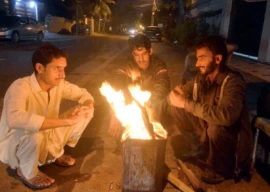
Her photographs feature mainly women who travel for miles every day in search of potable water and then work on the field for very low wages. By now she has over 2,000 photographs in her collection and she put 10 of these on display in a photo exhibition held last week in Noor Muhammad Thaeem Middle School in Thatta’s Gharo town.
The exhibition attracted a large number of villagers, students, teachers and civil society members. Everyone was excited to see what the middle-school children have captured through their lens and how truly they have depicted life in Gharo.
Over 60 photographs showing various aspects of village life went up on display. The collection was a compilation of the works of eight students. According to the organisers, these students will work as citizen journalists in the future by sending their works to various media houses.

“These are the agents of change for the community,” said Ayesha Javed, who works as communications officer at WaterAid, a UK-based organisation that organised the event.
Javed explained that her team held a series of meetings with community leaders and school teachers before selecting eight students - four girls and four boys - for this exhibition. “We gave them digital cameras and UK-based professional photographers trained them on how to take photos,” she said. Javed added that these photos will be exhibited at national and international forums as well and they are hoping to arrange other training courses to enhance the capacity of these students.
Reaching out: Photographs portray Pakistan’s resilience
During the project, class-eight student Kulsoom took over 1,500 photographs. One of her remarkable photos shows a woman washing clothes and kitchen utensil using dirty water. “This woman had no idea about the consequences of washing clothes with contaminated water and many other villagers also indulge in the same practice,” she said, adding that she has focused on how women suffer while working in the fields and fetching water.
Before starting photography, these students were also trained about issues confronted by the people in their areas. Thirteen-year-old Mir Jahan, who studies in class eight, worked with young girls who don’t go to school and help their parents in the field instead. “I have made around 1,100 photos of these girls who are busy sowing the paddy crop,” she said, pointing to her photograph in which a minor girl is working alongside her mother in the field under the scorching sun.
Class-seven student Riaz Thaeem said that he followed a man for a few days who fills dirty water from a canal and supplies it to people in Gharo and other areas. “One can find many stray dogs and other animals in the canal from where this man fills the water,” he pointed out.
Meanwhile, Aqib, who studies in Noor Mohammad Thaeem village, has captured various crops near the village and the acute water shortage that has hit standing crops. One of his photographs showed a woman who is busy cutting fodder for animals in the field. “This woman does not only fulfil the need of her own buffalo but sells it to others as well,” he said, adding that this woman uses all her earnings to pay for her children’s education.
Published in The Express Tribune, July 2nd, 2016.

1732745394-0/Diddy-(4)1732745394-0-165x106.webp)



1732697578-0/Untitled-design-(5)1732697578-0-270x192.webp)











COMMENTS
Comments are moderated and generally will be posted if they are on-topic and not abusive.
For more information, please see our Comments FAQ